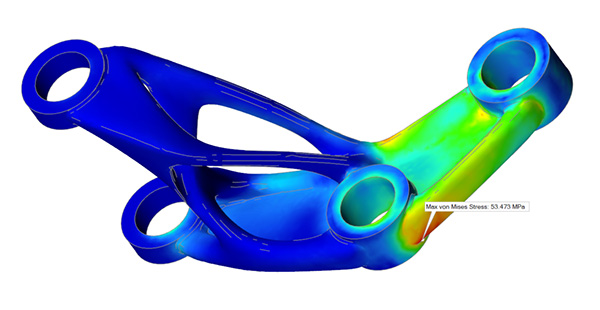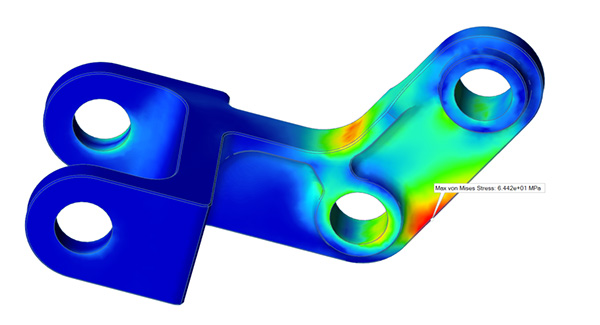Boosting CAD Interoperability
Consolidation and change within industries that use engineering design software raise questions about CAD software interoperability.

The optimized design shows a new material layout that decreases the maximum stress without adding additional mass to the part. Image courtesy of Altair.
Latest News
December 2, 2022
Industry consolidation has brought together many disparate CAD solutions from major vendors under one overarching roof. Many solutions still work in multi-CAD environments that pose challenges to sharing and working with disparate file types.
Collaboration with suppliers, vendors, end customers and third-party manufacturing partners can also complicate CAD translation and interoperability, presenting some challenges. However, overcoming challenges and embracing interoperability can lead to good results and utility by the engineering design community.
Surmountable Challenges?
The most streamlined solution when using a disparate system is a single integrated environment that delivers design, engineering and manufacturing tools built on a common platform, says Paul Brown, senior marketing director for product engineering solutions at Siemens Digital Industries Software.
“That allows information to flow seamlessly between disciplines and removes any issues with loss of important information. While this is not always possible it is the most productive solution,” says Brown.
“The reason for this comes back to the fundamental point that design data is much more than just a 3D model or 2D drawing,” he adds.
Brown explains that most companies seek to use the power of parametric modeling to build intelligence into designs; that is lost when users transfer data between systems. According to Brown, it’s nearly impossible to close the loop on design and analysis, allowing analysis systems to suggest design alternatives and optimized solutions based on parameters when lost in translation.
“Imagine a situation where an engineer has a component to analyze for performance. If they translate the data out the model data is passed into a CAE solution, then simplified, meshed and results are obtained. If the part needs updating, the results must be passed back to design, the designer then must interpret the results, work out how to make changes and then go through the cycle again,” Brown says.
What is needed, he says, is a single integrated solution built on a common set of data to remove the translation, allow faster iterations, and in certain cases allow the simulation engineer to try some solutions himself to allow him to offer better suggestions on changes to improve performance. This is closing the loop and improving turnaround.
Different companies have their own proprietary technology and formats. Not all industries are mature and can work across different formats. Standard translation software is not always available for many software industries, says Mohit Daga, senior manager for the governance portfolio for Dassault Systèmes
“The CAD industry is mature. There are industry-established neutral file formats like STEP and IGES, which are used to share data from one CAD tool to another,” says Daga. “Using neutral formats, however, means that you lose the connectivity to the original CAD file. If you make a change in the CAD file, it doesn’t carry through to the neutral files automatically, and then through to another CAD tool that you or your ecosystem might be using.”
Daga notes that Dassault Systèmes’ 3DEXPERIENCE Works portfolio offers seamless support for multi-CAD workflows where you do not have to worry about a neutral format and can still have the associativity to your original CAD file. All of this is possible while you continue to use other CAD tools or downstream applications such as simulation, data management and manufacturing.

Different Formats Challenges Data Integrity
Andrew Bartels is the vice president of program management for Altair. He says CAD is often passed between various stakeholders who span the system lifecycle, from design to production.
“As CAD is passed between internal departments, suppliers, contractors and customers it is commonly imported and exported between different tech stacks, which make interchange difficult and the ability to maintain data integrity challenging. Poor CAD interoperability impacts processes and can result in time-to-market delays. Development time is often compromised due to the need to provide additional employee training on multiple CAD programs and maintain CAD data, he says.
Bartel notes that Altair’s Inspire product can work with different file formats and modeling approaches to enable a highly efficient design process.
“From advanced parametric geometry creation and direct editing of native CAD data through to freeform PolyNURB modeling and editing, Inspire has the ability to interface with most formats and software design tools,” Bartels says.
“Getting everyone onto the same software family is only going to work well some of the time,” says John McCullough, general manager for marketing at Kubotek Kosmos. “If a company needs a complex plastic part produced quickly from a difficult-to-mold material, it does not make sense to start the search for a supplier by eliminating those that don’t use their same software. Obviously experience with that specific engineering challenge, resource availability and maybe cost are all more important criteria.”
McCullough adds that experts in areas such as numerically controlled programming and tooling design, whose time-pressured work is usually driven by 3D models sent by a customer, are usually not benefiting from the design history stored in the original CAD data.
“They typically do not edit the model and see a complex part as a whole different set of steps than the designer—often subtracted from stock material rather than formed from scratch by the 3D modeler,” he says. “The geometric 3D model is the common language between design and manufacturing and between CAD formats. Because of this core 3D language, it is rare for the differences between customer and part supplier systems to become a serious problem.”

Stephen Hooper, Autodesk vice president and general manager of Fusion 360
Interoperable design and engineering tools hinder efficiency in today’s business world—where nobody exists in a vacuum, says Stephen Hooper, vice president and general manager of Fusion 360 at Autodesk. Product companies partner with suppliers, manufacturers, certification authorities, shippers, fulfillment houses, the customer and a host of other external organizations, including all the business functions within the product company such as enterprise resource planning (ERP), manufacturing execution systems (MES) and product lifecycle management (PLM).
“All of these parties would benefit from having easy access to relevant pieces of information that are locked up in the CAD files,” Hooper says. “Working with files, rather than a single, central dataset, is like the age-old game of telephone: What reaches the end of the line takes a long time to get there, is usually a distorted version of the original, and the one-way flow of information eliminates collaboration. Choosing tools that aren’t natively designed to play nicely with others forces everyone involved to either purchase the same tools you use, settle for some ‘translation’ of the original file, or forgo partnering with you.”
Hooper also points out that when an organization’s tech stack is comprised of tools that aren’t natively interoperable, sometimes that interoperability challenge is overcome through bespoke interconnect solutions or integration work. When the original vendors update their tools or change how they save files, he says, integration work with all its associated costs may need to be repeated.
“Another common issue related to competitive advantage is an organization’s ability to implement the latest capabilities offered by vendors,” says Hooper. “It’s often the case that a customer is held back from implementing the latest design technology because their PLM system doesn’t support it, or vice versa. We recognize that standardizing one vendor is not necessarily the right solution. That is why we are building and advocating for a single open standard for a cloud information model in the manufacturing industry—one that is open and extensible to all, enabling customers to select the optimal solutions for their business and not be locked in or held hostage by a particular vendor.”
When learning any unfamiliar software platforms, Shekhar Burande, vice president of PLM and digital continuity at Capgemini Engineering, says engineers can get attached to the systems that they develop expertise on.
“The functions and features differ across the platform and get upgraded multiple times in a year,” Burande says. “Developing expertise on these platforms is a steep learning curve. Further efficiencies are extracted from the platform by developing automation and organizational knowledge. Moving to a different platform is an organizational change activity that is extremely complex and requires significant planning. This change would have to be decided by executive leadership and can be costly to execute.”
Overcoming Challenges and Managing the Way Ahead
Interoperability is not as much of a problem today as it used to be, says Lorant Olasz, technology director, external interfaces, COMSOL.
“Translators between CAD formats are always improving, and as a user you can usually find a format that works for exchanging the geometry,” says Olasz. “Smaller issues with a design can usually be easily identified and considered when developing efficient workflows, even when using several different software [platforms]. CAD interoperability issues can become a larger hurdle though for users less experienced with analysis.”
In time, differences in design platforms and interoperability will be more familiar to many and more manageable overall.
“What we find is that new designers and engineers are more open to picking up and trying new tools but established senior designers have created familiarity with certain tools and are less likely to pick up and use new tools—in other words they are stuck in their ways,” says Chris Mueth, new market development manager for Keysight Technologies.
“We do not think there will be a time where there will be a common GUI [graphical user interface] between tools, but the way the tools operate is similar, so this issue is largely manageable and new designers will require ramp-up time. Longer term, I believe [electronic design automation] and CAD companies will implement more application-specific features, which are automated, and [artificial intelligence/machine learning ] contributions will help smooth this ramp-up.”
More Altair Coverage
More Autodesk Coverage
More COMSOL Coverage
More Dassault Systemes Coverage

Subscribe to our FREE magazine, FREE email newsletters or both!
Latest News
About the Author
Jim Romeo is a freelance writer based in Chesapeake, VA. Send e-mail about this article to DE-Editors@digitaleng.news.
Follow DE







